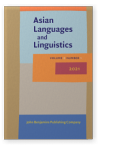Vol. 2:1 (2021) ► pp.110–133
An aggregate approach to diachronic variation in modern Chinese writings and translations
Modern Chinese took the place of classical Chinese and has been the standard form of writing since the early 1920s. While several studies have been carried out on diachronic variation in modern written Chinese, these include few aggregate investigations. This study examines the diachronic variation in modern Chinese writings and translations from the 1900s to the 2000s. Frequencies of multiple linguistic features sensitive to historical change were drawn from a multi-genre comparable corpus, ‘DCMCWT’, containing five periods: 1900–1911, 1919–1930, 1931–1949, 1950–1966, and 1978–2012. Hierarchical agglomerative clustering was employed for periodisation, while multidimensional scaling supplemented the developmental path. The results suggest that Chinese writings and translations fall into three broad periods: 1900–1911, 1919–1966, and 1978–2012. Chinese translations follow a similar evolutionary path as the writings, and the gap between them, narrowed from 1900 to 2012. This developmental path corresponds to the socio-historical backgrounds in Chinese history and shares similarities and differences with the development of English. Diachronic variation in early modern Chinese mirrors that of English in that both languages developed to be more colloquial and interactive. However, early modern Chinese is different from English, as diglossia has played a crucial evolutionary role.
Article outline
- 1.Introduction
- 2.Modern written Chinese from the early 1900s to the 2000s
- 3.Corpus and feature catalogue
- 3.1Corpus
- 3.2Feature catalogue
- 4.Methodology
- 4.1Hierarchical agglomerative clustering
- 4.2Multidimensional scaling
- 5.Results and discussion
- 5.1Hierarchical agglomerative clustering: Partitioning the time variants
- 5.2Multidimensional scaling results
- 6.Trends behind the diachronic variation
- 6.1The emergence, rise, and fall of diglossia
- 6.2Colloquialization
- 7.Conclusion
- Notes
-
References
